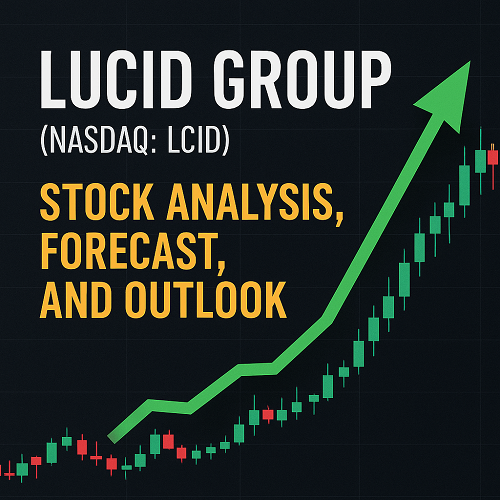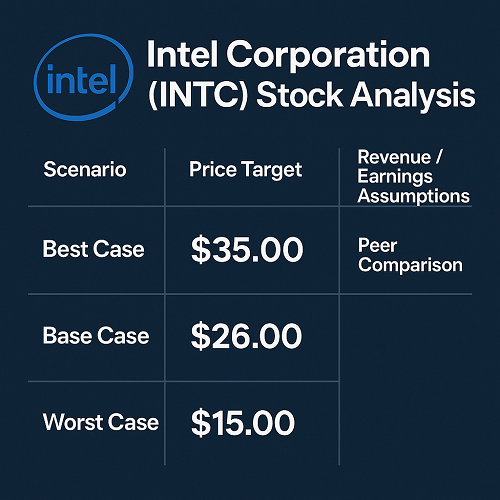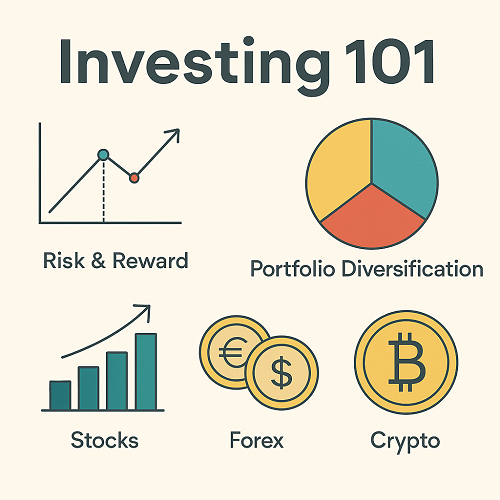Lucid Group, Inc. (NASDAQ: LCID) has become one of the most closely watched electric-vehicle (EV) stocks on Wall Street. Once hailed as the “Tesla challenger,” Lucid Motors’ sleek designs, advanced engineering, and Saudi-backed funding positioned it as a serious competitor in the luxury EV space.
But as the EV market matures and competition intensifies, investors are asking: Is LCID stock a buy, hold, or sell in 2025? This in-depth analysis explores Lucid’s business model, production trends, financial performance, strategic outlook, and realistic price forecasts.
Company Overview: Lucid’s Mission and Market Position
Lucid Group, Inc. is a California-based EV manufacturer focused on premium all-electric sedans and, soon, SUVs. Founded by Peter Rawlinson, former Chief Engineer of the Tesla Model S, Lucid aims to deliver the world’s most efficient and luxurious electric cars.
- Headquarters: Newark, California
- Founded: 2007 (as Atieva, rebranded to Lucid Motors in 2016)
- Ticker: LCID (NASDAQ)
- Market Cap (as of October 2025): ≈ $7 billion
- Key Model: Lucid Air — EPA range > 500 miles, one of the longest in the EV market
- Upcoming Model: Lucid Gravity SUV (expected late 2025)
Lucid’s vehicles target the luxury EV segment, directly competing with Tesla Model S, Mercedes EQS, and Porsche Taycan. Its competitive advantage lies in battery efficiency, aerodynamics, and fast-charging technology developed in-house.
Recent Performance: Production, Deliveries, and Market Trends
Production and Deliveries
Lucid has struggled to scale production to meet demand, but incremental improvements are visible:
- 2023 Deliveries: ~8,400 vehicles
- 2024 Deliveries: ~10,500 vehicles (estimated +25% YoY growth)
- Target for 2025: 15,000 – 18,000 units (assuming Gravity launch on schedule)
Lucid continues to face supply-chain bottlenecks and cost-reduction challenges, common in early-stage automakers. However, partnerships and direct funding from the Public Investment Fund (PIF) of Saudi Arabia have provided critical financial stability.
Financial Snapshot
| Metric | FY 2023 | FY 2024 (Est.) | YoY Change |
|---|---|---|---|
| Revenue | $595 M | $890 M | +49 % |
| Net Loss | -$2.9 B | -$2.4 B | -17 % |
| Gross Margin | -85 % | -62 % | Improving |
| Cash Reserves | $4.4 B | $3.9 B | Strong Liquidity |
Lucid remains in a growth-at-a-loss phase, burning cash to scale manufacturing and expand globally.
Key Growth Drivers and Opportunities
1. Lucid Gravity SUV Launch
The upcoming Gravity SUV could be a game-changer. Entering the most profitable EV segment — luxury crossovers — Gravity may double Lucid’s addressable market and boost its average selling price (ASP).
Analysts expect deliveries to start in late 2025, with a strong pre-order book if execution remains on schedule.
2. Saudi Expansion and Global Reach
Lucid’s Saudi Arabia plant (AMP-2) is pivotal for international growth. Backed by the PIF, the facility aims for annual capacity of ~150,000 units and localized production for Middle-East and European markets.
This strategic partnership gives Lucid access to billions in funding, infrastructure incentives, and guaranteed fleet orders from the Saudi government.
3. Proprietary Battery Technology
Lucid’s in-house powertrain and battery systems remain among the industry’s most efficient, achieving up to 4.6 miles per kWh — a key differentiator in range and charging speed.
Lucid’s future may include licensing this technology to other automakers, diversifying its revenue streams.
Major Risks and Challenges
1. Ongoing Cash Burn and Dilution
Despite its solid balance sheet, Lucid’s operating losses remain steep. Sustained R&D and factory buildouts mean further equity dilution or debt financing is likely by 2026 unless profitability improves.
2. Weak Demand in Luxury EVs
The global luxury-EV market is slower-growing than mass-market EVs. As interest rates stay high, consumer appetite for $80k+ EVs remains limited, forcing Lucid to offer discounts that compress margins.
3. Competitive Pressure
Lucid competes with Tesla, Mercedes-Benz, BMW, Porsche, and emerging Chinese brands such as BYD and NIO. With incumbents scaling production faster and cheaper, Lucid must maintain technological superiority to survive.
4. Execution Risk
Delays in production, new-model launches, or supply disruptions can severely impact sentiment. A single quarter of under-delivery can trigger steep price volatility in LCID stock.
Lucid Stock Technical and Valuation Analysis
Stock Performance
As of October 2025, LCID trades near $3.85 per share, down from over $55 in 2021. The prolonged decline mirrors investor skepticism toward unprofitable EV startups.
Key Technical Levels
| Level | Type | Significance |
|---|---|---|
| $3.50 – 3.80 | Support | Historical consolidation zone |
| $5.20 | Resistance | Short-term breakout level |
| $7.00 – 7.50 | Major resistance | 2024 swing high range |
A sustained move above $5.20 with strong volume could signal a trend reversal. Conversely, a break below $3.40 may expose LCID to new lows.
Valuation Metrics
| Metric | LCID | Tesla | Rivian |
|---|---|---|---|
| Price / Sales (2025E) | ≈ 7.8× | 7.1× | 5.4× |
| EV / Revenue | 8.2× | 6.5× | 5.9× |
| Gross Margin | -62 % | 25 % | -20 % |
Despite its small revenue base, LCID’s valuation remains lofty relative to fundamentals, suggesting speculative premium pricing.
Investor Sentiment and Institutional Holdings
Large stakeholders — notably the Saudi PIF (≈ 60 % ownership) — continue to support Lucid financially. However, institutional participation from U.S. funds has declined since 2023, reflecting short-term pessimism about profitability timelines.
Retail investors, on the other hand, still view LCID as a potential turnaround play, betting on long-term EV adoption.
Trading Strategies for LCID Stock
Short-Term Traders
- Strategy: Trade between $3.50 support and $5.20 resistance.
- Indicators: Monitor RSI (> 60 for bullish momentum) and 50-day MA crossover.
- Volatility: Average daily range > 5 %, ideal for day- and swing-traders.
Medium-Term Investors
- Approach: Accumulate near $3.50–$4.00 range, target $7–$8 by Q3 2026.
- Risk Management: Stop loss < $3.00.
- Catalysts: Gravity launch updates, quarterly delivery reports.
Long-Term Position Traders
- Outlook: Hold through 2027 if Lucid achieves > $3 B in annual revenue.
- Thesis: Technology licensing + Saudi expansion + SUV sales = potential multi-bagger.
- Bear Case: Failure to reach scale → stock dilution → delisting risk by 2030.
Lucid Stock Forecast: 2025 – 2030
| Year | Bull Case | Base Case | Bear Case |
|---|---|---|---|
| 2025 | $7.50 | $4.50 | $2.50 |
| 2026 | $12.00 | $6.00 | $3.00 |
| 2027 | $20.00 | $9.00 | $4.00 |
| 2030 | $45.00 | $18.00 | $6.00 |
Lucid’s long-term trajectory depends on its ability to reach mass production, expand into SUVs, and improve margins. The base-case forecast assumes gradual efficiency gains and steady funding from PIF.
Conclusion: Is LCID Stock Worth Buying Now?
Lucid Motors represents both promise and peril. On one hand, its technology, design, and deep-pocketed backing give it a realistic shot at survival. On the other, operational losses and slow scaling keep the stock speculative.
For traders: LCID remains a high-volatility play best approached with disciplined technical setups.
For long-term investors: It’s a patient hold only if you believe in Lucid’s execution and the broader EV megatrend.
If Lucid successfully launches Gravity, expands globally, and narrows its losses, LCID could reclaim investor confidence — but until then, caution and strategic entry levels are key.
FAQs about Lucid Group (LCID)
1. What does Lucid Motors do?
Lucid designs and manufactures premium electric vehicles known for luxury, efficiency, and long range.
2. Why is LCID stock so volatile?
High operating losses, low production volume, and heavy short interest make LCID prone to sharp price swings.
3. Who owns Lucid?
The Saudi Public Investment Fund (PIF) is the majority shareholder with ≈ 60 % ownership.
4. Is Lucid profitable?
Not yet. The company aims for gross-margin breakeven by 2027 through cost reduction and higher output.
5. Is LCID a good investment for 2025?
Lucid remains speculative. Conservative investors should wait for clear signs of scaling success; risk-tolerant traders can exploit volatility for short-term gains.





 XAUT-USD
XAUT-USD  AMD
AMD  MARA
MARA  SHOP
SHOP  BULL
BULL  CL=F
CL=F